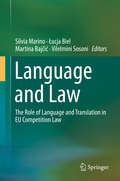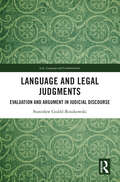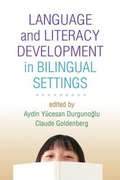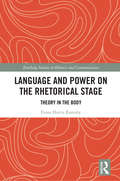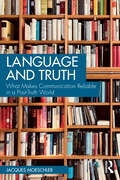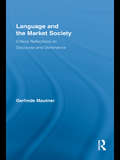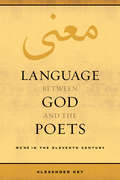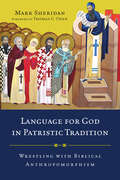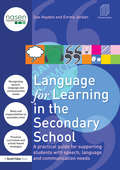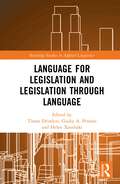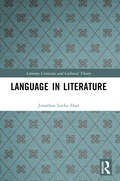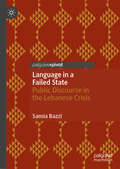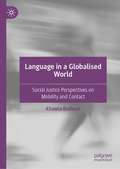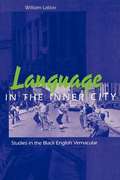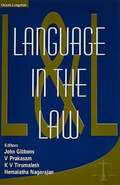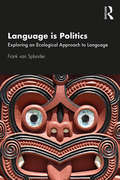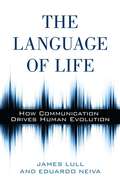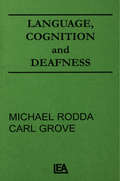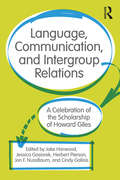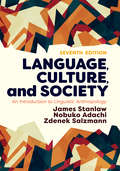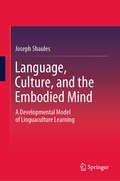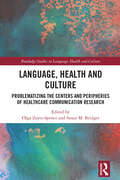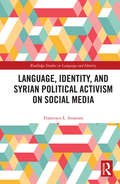- Table View
- List View
Language and Law: The Role Of Language And Translation In Eu Competition Law
by Silvia Marino Łucja Biel Martina Bajčić Vilelmini SosoniThe book provides an overview of EU competition law with a focus on the main developments in Italy, Spain, Greece, Poland and Croatia and offers an in-depth analysis of the role of language, translation and multilingualism in its implementation and interpretation.The first part of the book focuses on the main developments in EU competition law in action, which includes legislation, case law and praxis. This part can be divided into two subparts: the private enforcement of EU competition law, and the cooperation among enforcers, i.e. the EU Commission, the national competition authorities and the national courts. Language is of paramount importance in the enforcement of EU competition law, and as such, the second part highlights legal linguistic skills, showcasing the advantages and the challenges of multilingualism, especially in the context of the predominant use of English as the EU drafting and vehicular language.The volume brings together contributions prepared and presented as part of the EU-funded research project “Training Action for Legal Practitioners: Linguistic Skills and Translation in EU Competition Law".
Language and Legal Judgments: Evaluation and Argument in Judicial Discourse (Law, Language and Communication)
by Stanisław Goźdź-RoszkowskiIntegrating research methods from Linguistics with contemporary Legal Argumentation Theory, this book highlights the complexities of legal justification by focusing on the role of value-laden language in argument construction and use. The combination of linguistic analysis and the pragma-dialectic approach to legal argumentation yields a new way of perceiving and understanding the phenomenon of evaluation, one that offers theoretical and practical gains. Analyzing a vast corpus of judicial opinions from the United States Supreme Court and Poland’s Constitutional Court, the book paints a clear picture of complex linguistic choices made by judges to assess and support arguments in the justifications of their decisions. The book will be of interest to scholars in Law, Linguistics and Rhetoric, as well as to judges and practicing lawyers engaged in the art of argumentation.
Language and Literacy Development in Bilingual Settings
by Claude Goldenberg Aydin DurgunogluGrounded in state-of-the-art research, this book explores how English language learners develop both the oral language and literacy skills necessary for school success. Chapters examine the cognitive bases of English acquisition, and how the process is different for children from alphabetic (such as Spanish) and nonalphabetic (such as Chinese) language backgrounds. The book addresses a key challenge facing educators and clinicians identifying students whose poor English skills may indicate an underlying impairment, as opposed to still-developing language proficiency. Implications for diagnosis, intervention, and instruction are highlighted throughout.
Language and Power on the Rhetorical Stage: Theory in the Body (Routledge Studies in Rhetoric and Communication)
by Fiona Harris RamsbyThrough a fusion of narrative and analysis, Language and Power on the Rhetorical Stage examines how theater can enact critical discourse analysis and how micro-instances of iniquitous language use have been politically and historically reiterated to oppress and deny equal rights to marginalized groups of people. Drawing from Aristophanes’ rhetorical plays as a template for rhetoric in action, the author poses the stage as a rhetorical site whereby we can observe, see, and feel 20th-century rhetorical theories of the body. Using critical discourse analysis and Judith Butler’s theories of the performative body as a methodological and analytical lens, the book explores how a handful of American plays in the latter part of the 20th century—the works of Tony Kushner, Suzan Lori-Parks, and John Cameron Mitchell, among others— use rhetoric in order to perform and challenge marginalizing language about groups that are not offered center stage in public and political spheres. This innovative study initiates a conversation long overdue between scholars in rhetorical and performance studies; as such, it will be essential reading for academic researchers and graduate students in the areas of rhetorical studies, performance studies, theater studies, and critical discourse analysis.
Language and Translation in Postcolonial Literatures: Multilingual Contexts, Translational Texts (Routledge Research in Postcolonial Literatures)
by Simona BertaccoThis collection gathers together a stellar group of contributors offering innovative perspectives on the issues of language and translation in postcolonial studies. In a world where bi- and multilingualism have become quite normal, this volume identifies a gap in the critical apparatus in postcolonial studies in order to read cultural texts emerging out of multilingual contexts. The role of translation and an awareness of the multilingual spaces in which many postcolonial texts are written are fundamental issues with which postcolonial studies needs to engage in a far more concerted fashion. The essays in this book by contributors from Australia, New Zealand, Zimbabwe, Cyprus, Malaysia, Quebec, Ireland, France, Scotland, the US, and Italy outline a pragmatics of language and translation of value to scholars with an interest in the changing forms of literature and culture in our times. Essay topics include: multilingual textual politics; the benefits of multilingual education in postcolonial countries; the language of gender and sexuality in postcolonial literatures; translational cities; postcolonial calligraphy; globalization and the new digital ecology.
Language and Truth: What Makes Communication Reliable in a Post-Truth World
by Jacques MoeschlerThe nature of truth is a current preoccupation both in political and social debates. The emergence and consequences of fake news and misinformation are at the core of what some call a post-truth world.Divided into two parts, Language and Truth develops the theoretical framework of language, truth, and communication. The book illustrates the way in which fake news is adhered to or rejected using case studies taken from political discourse such as the recent use of the word’s “genocide” and “denazification” by Vladimir Putin. It explores sources of information such as gossip and the everyday as well as exceptional uses of language such as humour.This is vital reading for scholars, researchers, and students of pragmatics, semantics, philosophy of language, cognitive psychology, sociolinguistics, language and communication, and language and politics within linguistics, psychology, and communication studies.
Language and the Market Society: Critical Reflections on Discourse and Dominance (Routledge Critical Studies In Discourse Ser. #2)
by Gerlinde MautnerIn education, politics and religion, there are strong indications that discourse is becoming marketized. Around the world, government ministries have re-defined themselves as "service providers," universities draw up "market-driven" curricula, job seekers are asked to "package themselves" more effectively, and there are advertising agencies specializing in "the Christian marketplace." And it is not only word choice that is effected; higher-level linguistic patterns, such as genres and discursive practices (such as the text and talk connected with performance measurement and public relations), are also drawn into the orbit of market forces. Through an intricate dialectic, such patterns of linguistic choices, in turn, reinforce the social structures that shape them, further consolidating the marketization process. In a related development, language within the business domain itself is increasingly shaped by strategic planning and control, for example in branding, message design, and the promulgation of management buzzwords. Marketization thus emerges as a globally unfolding process in which language holds a key position as both cause and effect, and as both subject and object. The book examines these phenomena from a linguistic and critical perspective, drawing on critical discourse analysis, sociological treatises of market society, and critical management studies.
Language and the Right to Fair Hearing in International Criminal Trials
by Catherine S. NamakulaLanguage and the Right to Fair Hearing in International Criminal Trials explores the influence of the dynamic factor of language on trial fairness in international criminal proceedings. By means of empirical research and jurisprudential analysis, this book explores the implications that conducting a trial in more than one language can have for the right to fair trial. It reveals that the language debate is as old as international criminal justice, but due to misrepresentation of the status of language fair trial rights in international law, the debate has not yielded concrete reforms. Language is the core foundation for justice. It is the means through which the rights of the accused are secured and exercised. Linguistic complexities such as misunderstandings, translation errors and cultural distance among participants in international criminal trials affect courtroom communication, the presentation and the perception of the evidence, hence jeopardizing the foundations of a fair trial. The author concludes that language fair trial rights are priority rights situated in the minimum guarantees of fair criminal trial; the obligation of the court to ensure fair trial or accord the accused person a fair hearing also includes the duty to ensure they can understand and be understood.
Language between God and the Poets: Ma‘na in the Eleventh Century (Berkeley Series in Postclassical Islamic Scholarship #2)
by Alexander KeyA free ebook version of this title is available through Luminos, University of California Press’s Open Access publishing program. Visit www.luminosoa.org to learn more. In the Arabic eleventh-century, scholars were intensely preoccupied with the way that language generated truth and beauty. Their work in poetics, logic, theology, and lexicography defined the intellectual space between God and the poets. In Language Between God and the Poets, Alexander Key argues that ar-Raghib al-Isfahani, Ibn Furak, Ibn Sina (Avicenna), and Abd al-Qahir al-Jurjani shared a conceptual vocabulary based on the words ma‘na and haqiqah. They used this vocabulary to build theories of language, mind, and reality that answered perennial questions: how to structure language and reference, how to describe God, how to construct logical arguments, and how to explain poetic affect.
Language for God in Patristic Tradition: Wrestling with Biblical Anthropomorphism
by Mark SheridanLanguage for God in Patristic Tradition
Language for Learning in the Secondary School: A Practical Guide for Supporting Students with Speech, Language and Communication Needs (nasen spotlight)
by Sue Hayden Emma JordanLanguage for Learning in the Secondary School employs the same easy-to-use format as the best-selling Primary version of this book but has been adapted to meet the specific needs of secondary school teachers. This indispensable resource is packed full of practical suggestions on how to support students with speech, language and communication difficulties. Colour coded throughout for easy referencing, this unique book supports inclusive practice by helping you to: Identify students with speech, language and communication needs Understand how language is processed Consider roles and responsibilities at secondary level Plan a differentiated curriculum Consider the language demands across the subjects Adopt a whole school approach Make use of a wide range of positive strategies Empower students to access the curriculum. Language for Learning in the Secondary School comes complete with a wealth of photocopiable resources and activities, giving teachers and teaching assistants the confidence to help students with speech, language and communication needs more effectively in mainstream settings. It will also be an extremely useful resource for specialist teachers, speech and language therapists and educational psychologists.
Language for Legislation and Legislation through Language (Routledge Studies in Applied Linguistics)
by Helen Xanthaki Tímea Drinóczi Giulia A. PennisiThis collection teaches us how language and legislation interact to produce effective laws. It brings linguistics, lawyers, theory, and practices together to show how linguistic tools, concepts, and methodologies can be applied to improve the law’s clarity, transparency, and efficiency, thus widening its social reach.Drawing on case studies across Europe, chapters critically reflect on the dynamics of legislative drafting and the dissemination of legislation and the ways in which drafted legislation both creates laws and serves to communicate their meaning. This volume features perspectives from national and transnational examples to demonstrate the impact of varied stakeholders—legislative bodies, law interpreters, and law enforcers—on the implementation of legislation, particularly when legislative texts are translated and interpreted across different settings. Through the lens of discourse analysis, legislative texts are analyzed in lexico‑grammatical and textual terms, highlighting the disparity between what is conceived and what might be expressed clearly in words and how this knowledge can inform better drafting practices. This collection charts a way forward for linguistics as a discipline to contribute to a better understanding of the nuances around effective legislative expression.This book will appeal to scholars and stakeholders working at the intersection of language and the law, in such fields as applied linguistics, forensic linguistics, regulation, legislation, and legislative drafting.
Language in Literature (Literary Criticism and Cultural Theory)
by Jonathan Locke HartLanguage in Literature examines the overlap and blurring boundaries of English, comparative and world poetry and literature. Questions of language, literature, translation and creative writing are addressed as befitting an author who is a poet, literary scholar and historian. The book begins with metaphor, which Aristotle thought, in Poetics, was the key gift of the poet, and discusses it in theory and practice; it moves from the identity of metaphor to identity in translation and culture; it examines poetry in a comparative and world context; it looks at image and text; it explores literature and culture in the Cold War; it explores the role of the poet and scholar in translating poetry East and West; it places creative writing in theory and practice in context East and West; it concludes by summing up and suggesting implications of creation in language, translating and interpreting, and its expression in literature, especially in poetry.
Language in a Failed State: Public Discourse in the Lebanese Crisis
by Samia BazziThis book examines public, political and media discourse in the context of failed states using Lebanon, a country torn by wars and political-financial corruption, as a contemporary case study. Using critical discourse analysis (CDA), the author brings political and economic theories into dialogue with socio-linguistics to argue that public discourse in a failed state not only plays a role in that collapse but is a key presenting symptom of social disintegration. Through CDA, the book makes this phenomenon visible, and contributes to existing definitions of the concept “failed” or “fragile” state. In addition, the qualitative data and analysis provided offer a tool to assess a state’s vulnerability to collapse. The book also expands the sociolinguistic model to eavesdrop on the zeitgeist of the nation in order to examine the degrees of social cohesion, sectarianism and bonding. This book will be of interest to discourse analysts, journalists, politicians, policy-makers, and economists.
Language in a Globalised World: Social Justice Perspectives on Mobility and Contact
by Khawla BadwanThis book takes a critical look at the role of language in an increasingly diversified and globalised world, using the new framework of 'sociolinguistics of globalisation' to draw together research from human geography, sociolinguistics, and intercultural communication. It argues that globalisation has resulted in a destabilisation of social and linguistic norms, and presents a ‘language-in-motion’ approach which addresses the inequalities and new social divisions brought by the unprecedented levels of population mobility. This book looks at language on the individual, national and transnational level, and it will be of interest to readers with backgrounds in history, politics, human geography, sociolinguistics and minority languages.
Language in the Inner City: Studies in the Black English Vernacular (Conduct and Communication)
by William Labov<p>With the recent controversy in the Oakland, California school district about Ebonics—or as it is referred to in sociolinguistic circles, African American Vernacular English or Black English Vernacular—much attention has been paid to the patterns of speech prevalent among African Americans in the inner city. <p>In January 1997, at the height of the Ebonics debate, author and prominent sociolinguist William Labov testified before a Senate subcommittee that for most inner city African American children, the relation of sound to spelling is different, and more complicated than for speakers of other dialects. He suggested that it was time to apply this knowledge to the teaching of reading. <p>The testimony harkened back to research contained in his groundbreaking book Language in the Inner City, originally published in 1972. In it, Labov probed the question "Does 'Black English' exist?" and emerged with an answer that was well ahead of his time, and that remains essential to our contemporary understanding of the subject. <p>Language in the Inner City firmly establishes African American Vernacular English not simply as slang but as a well-formed set of rules of pronunciation and grammar capable of conveying complex logic and reasoning. Studying not only the normal processes of communication in the inner city but such art forms as the ritual insult and ritualized narrative, Labov confirms the Black vernacular as a separate and independent dialect of English. His analysis goes on to clarify the nature and processes of linguistic change in the context of a changing society. <p>Perhaps even more today than two decades ago, Labov's conclusions are mandatory reading for anyone concerned with education and social change, with African American culture, and with the future of race relations in this country.</p>
Language in the Law
by John Carey V. Prakasam John Gibbons K. V. TirumaleshThe Language in the Law records the different modes and practices in the use of language related to law. The nexus between language and the law in various countries and cultures is examined in this book.
Language is Politics: Exploring an Ecological Approach to Language
by Frank van SplunderLanguage is Politics discusses power relations between languages in the world, with a particular focus on English. Even though English is the most widely spoken and the most powerful language worldwide, it is not the lingua franca it is often supposed to be. The basic tenet of this book is that languages do not exist in the natural world; they are artefacts made by humans. The book debunks some common myths about language and it suggests that we should be more modest in our assumptions, for instance concerning the linguistic uniqueness of our own species. The author argues in favour of an ecological or balanced approach to language. This approach sees humans and other animals as part of the larger ecosystems that life depends on. As in nature, diversity is crucial to the survival of languages. The current linguistic ecosystem is out of balance, and this book shows that education can help to restore the balance and cope with the challenges of a multilingual and multicultural world. With an ecological approach to language and a focus on narratives and personal language histories, this will be key reading for researchers and academics, as well as students of English language and linguistics.
Language of Life: How Communication Drives Human Evolution
by James Lull Eduardo NeivaCommunication in its most basic form-the sending of signals and exchange of messages within and between organisms-is the heart of evolution. From the earliest life-forms to Homo sapiens, the great chain of communication drives the evolutionary process and is the indispensable component of human culture. That is the central message of this unique perspective on both the biological evolution of life and the human development of culture. The book explores the totality of communication processes that create and sustain biological equilibrium and social stability. The authors argue that this ubiquitous connectivity is the elemental unity of life. Introducing a new subdiscipline-evolutionary communication-the authors analyze the core domains of life-sheer survival, sex, culture, morality, religion, and technological change-as communications phenomena. What emerges from their analysis is a brilliant interpretation of life interconnected through communication from the basic molecular level to the most sophisticated manifestations of culture. Challenging the boundaries of conventional approaches to cultural analysis, this is an original and engaging view of evolution and an encouraging prognosis for our collective future.
Language, Cognition, and Deafness
by Michael Rodda Carl GroveFirst published in 1987. Routledge is an imprint of Taylor & Francis, an informa company.
Language, Communication, and Intergroup Relations: A Celebration of the Scholarship of Howard Giles
by Jon F. Nussbaum Jessica Gasiorek Jake Harwood Herbert D. Pierson Cynthia GalloisLanguage, Communication, and Intergroup Relations presents the current state of knowledge at the intersection of language, communication, and intergroup relations, drawing on interdisciplinary work from the fields of communication, social psychology, and sociolinguistics. Building from that existing work, it presents a series of provocative and innovative new directions in this area. The work is organized around a series of five themes: • Language and Culture • Intergroup Communication • Intergenerational Relations • Interpersonal Accommodation • Institutional Accommodation. Within each theme, prominent scholars present reviews of the literature, which are followed by responses, reactions, and extensions from a multidisciplinary group of researchers. These responses often move beyond typical academic prose and engage with the material in novel ways, including graphical theoretical models, short personal reflections, and creative prose. It is essential reading for students and academics in the interdisciplinary fields of communication, language, and social psychology.
Language, Culture, and Society: An Introduction to Linguistic Anthropology
by Zdenek Salzmann James Stanlaw Nobuko AdachiWhy should we study language? How do the ways in which we communicate define our identities? And how is this all changing in the digital world? Since 1993, many have turned to Language, Culture, and Society for answers to questions like those above because of its comprehensive coverage of all critical aspects of linguistic anthropology. This seventh edition carries on the legacy while addressing some of the newer pressing and exciting challenges of the 21st century, such as issues of language and power, language ideology, and linguistic diasporas. Chapters on gender, race, and class also examine how language helps create-and is created by-identity. New to this edition are enhanced and updated pedagogical features, such as learning objectives, updated resources for continued learning, and the inclusion of a glossary. There is also an expanded discussion of communication online and of social media outlets and how that universe is changing how we interact. The discussion on race and ethnicity has also been expanded to include Latin- and Asian-American English vernacular.
Language, Culture, and the Embodied Mind: A Developmental Model of Linguaculture Learning
by Joseph ShaulesThere is an odd contradiction at the heart of language and culture learning: Language and culture are, so to speak, two sides of a single coin—language reflects the thinking, values and worldview of its speakers. Despite this, there is a persistent split between language and culture in the classroom. Foreign language pedagogy is often conceptualized in terms of gaining knowledge and practicing skills, while cultural learning goals are often conceptualized in abstract terms, such as awareness or criticality.This book helps resolve this dilemma. Informed by brain and mind sciences, its core message is that language and culture learning can both be seen as a single, interrelated process—the embodiment of dynamic systems of meaning into the intuitive mind. This deep learning process is detailed in the form of the Developmental Model of Linguaculture Learning (DMLL). Grounded in dynamic skill theory, the DMLL describes four developmental levels of language and culture learning, which represents a subtle, yet important shift in language and culture pedagogy. Rather than asking how to add culture into language education, we should be seeking ways to make language and culture learning deeper—more integrated, embodied, experiential and transformational. This book provides a theoretical approach, including practical examples, for doing so.
Language, Health and Culture: Problematizing the Centers and Peripheries of Healthcare Communication Research (Routledge Studies in Language, Health and Culture)
by Susan M. Bridges Olga Zayts-SpenceLanguage, Health and Culture brings together contributions by linguistic scholars working in the area of health communication in Asia—in particular, in Hong Kong, Mainland China, Singapore, Japan and Taiwan. Olga Zayts-Spence and Susan M. Bridges, along with the contributors, draw on a diverse range of authentic data from different (primary, secondary, digital) healthcare contexts across Asia. The contributions probe empirical analyses and meta-reflections on the empirical, epistemological and theoretical foundations of doing research on language and health communication in Asia. While many of the medical and technological advances originate from the ‘non-English-dominant’/‘peripheral’ contexts, when it comes to health communication, there is a strong tendency to downplay and marginalize the scope and the impact of the ripe research tradition in these contexts. The contributions to the edited volume problematize the hegemony of dominant (Anglocentric) traditions in health communication research by highlighting culture- and context-specific ways of interpreting different health realities through linguistic lenses.
Language, Identity, and Syrian Political Activism on Social Media (Routledge Studies in Language and Identity)
by Francesco L. SinatoraLanguage, Identity, and Syrian Political Activism on Social Media is an empirical contemporary Arabic sociolinguistic investigation informed by theories and notions developed in the fields of Arabic linguistics, sociolinguistics, discourse analysis and linguistic anthropology. Building on the Bakhtinian concept of linguistic hybridity, this book conducts a longitudinal analysis of Syrian dissidents’ social media practices between 2009 and 2017. It shows how dissidents have used social media to emerge in the discourse about the Syrian conflict and how language has been used symbolically as a tool of social and political engagement in an increasingly complex sociopolitical context. This monograph is ideal for students, sociolinguists and researchers interested in Arabic language and identity.
